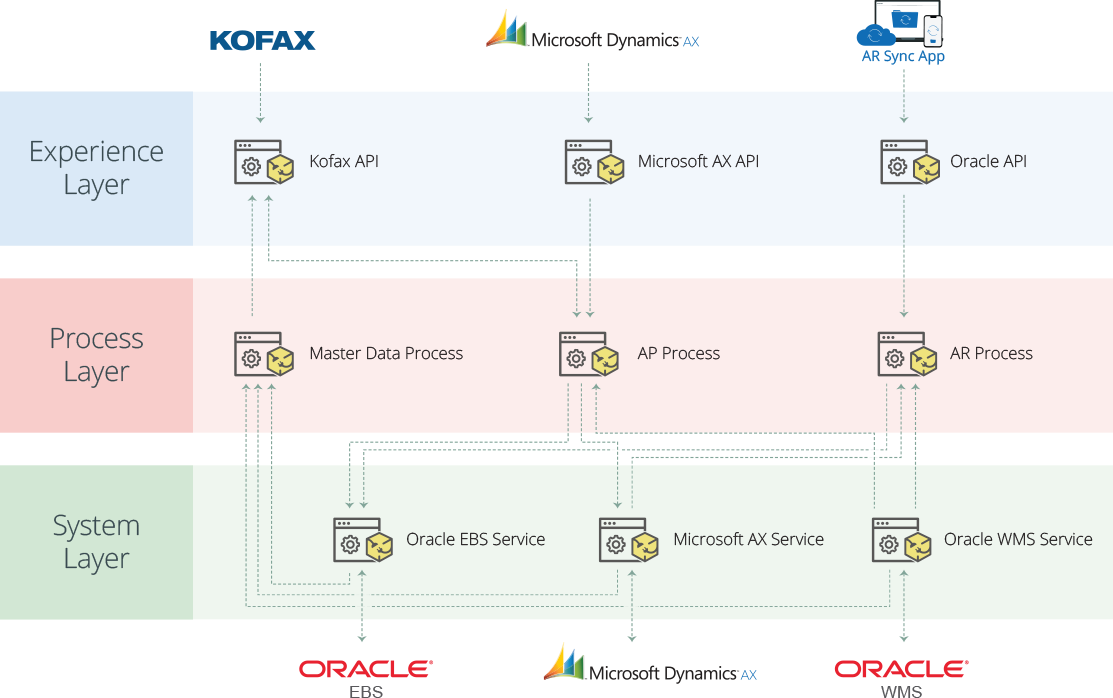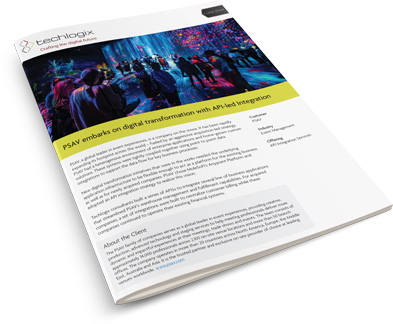PSAV, a global leader in event experiences, is a company on the move. It has been rapidly expanding its footprint across the world – fueled by an aggressive acquisition-led strategy. PSAV had a heterogenous environment of enterprise applications and home-grown custom solutions. These systems were tightly coupled together using point to point data integrations to support the data flow for key business processes.
New digital transformation initiatives that were in the works needed the underlying application infrastructure to be flexible enough to act as a platform for the existing business as well as for newly acquired companies. PSAV chose MuleSoft’s Anypoint Platform and adopted an API integration strategy to realize this vision.
Techlogix consultants built a series of APISs to integrate several line of business applications that streamlined PSAV’s warehouse management and fulfillment capabilities. For acquired companies, a set of integrations were built to centralize customer billing while these companies continued to operate their existing financial systems.

The Vision
Since taking charge as the Senior Vice President of Information Technology at PSAV, Nick Mahmood wanted to transform PSAV into a successful digital business. “I wanted to embark on a digital journey where the ultimate goal is to deliver differentiated customer and digital experiences. The existing integration initiatives to support this transformation were siloed as they did not focus on the synergies brought by Digital Integration as an enterprise-wide strategic capability. I strongly believe that a strategic view of Digital Integration is a must if one is to achieve success in one’s digital transformation initiatives.”
Nick realized quickly that the existing point-to-point data integration methods that PSAV had employed would not be flexible enough for digital transformation. PSAV needed to bring data from disparate sources to multiple consumers, such as customers, suppliers, and employees. Online and mobile applications in the future rollout plan were expected to have a much higher frequency of change than PSAV’s existing line of business applications.
Technology
After months of evaluating different integration tools, PSAV’s team chose MuleSoft’s Anypoint Platform to truly deliver on their digital transformation through realizing API-led connectivity. The MuleSoft platform was the only solution that enabled end-to-end connectivity across API, service orchestration, and application integration needs through a single unified platform. This allows developers to rapidly connect, orchestrate and enable any internal or external endpoint. Furthermore, the solution was flexible enough to be rapidly deployed on-premises, or accessed as a cloud solution.
Solution Requirements
To streamline its warehouse management and fulfillment capabilities, PSAV was in the process of rolling out Oracle Warehouse Management Cloud (WMS) – the industry’s leading cloud-based inventory and warehouse management system. This new system had to be seamlessly integrated with Oracle iProcurement that PSAV had been using for years.
Multiple bi-directional connectivity requirements had to be fulfilled: Item and Supplier master data, as well as Purchase and Sales Orders had to be moved from the procurement module to WMS. The receiving against POs had to be done in WMS and confirmations for receipt of POs and shipments had to be moved from WMS to the procurement module. A similar cycle needed to be executed for Sales Orders.
PSAV wanted to setup a base set of APIs that would help in streamlining financial processes of newly acquired companies. It wanted to make its current Oracle iProcurement as the master system of record for all vendors/suppliers – the supplier management team would be creating and updating suppliers in Oracle iProcurement and that would trigger creation and/or updates in the relevant systems across the acquired companies.
PSAV also wanted to process all accounts receivables from their central Oracle system for acquired companies as well. So, the requirement was for each company to be able to post its invoices, credit memos and cash deposits, etc. to the central Oracle system.
Another new initiative PSAV undertook was for Invoice Automation in Accounts Payable (AP). It had a manual process where the AP team in finance would manually match the invoices with receipts and process the payables for each vendor. PSAV implemented Kofax for 2-way and 3-way automated invoice matching process. Workflows in Kofax were setup to ingest incoming invoice PDFs, extract information from those invoices, perform lookups from relevant systems, perform the match based on configured business rules and then post the matched invoices into Oracle iProcurement for payment processing. Kofax needed a set of APIs to fetch Supplier and Purchase Order data and then post the matched invoices.

Techlogix consultants have significantly bolstered our API-based integration efforts, helping us transform IT into a platform for the business. By exposing data assets as a set of services offered to a broader audience, PSAV’s IT is increasingly becoming a platform to drive our digital transformation initiatives.
Nick Mahmood
SVP, Information Technology at PSAV
The Project
PSAV’s Integration team evaluated several vendors and chose Techlogix to build the solution. A Techlogix Integration Architect worked with the PSAV team to analyze and document business requirements for the various integrations involved. Using our sophisticated methodology, data mapping documents were generated. Based on these artifacts, an offshore team of integration developers designed and built a set of API integrations related to inventory master data, supplier master data, vendor master data, purchase and sales orders.
“Three-Tier” API-led connectivity architecture
A large enterprise such as PSAV has complex, interwoven connectivity needs that require multiple API-led connectivity building blocks. Putting in a framework for ordering and structuring these building blocks that provide agility and flexibility necessitated a multi-tier architecture containing 3 distinct layers:
- System Layer: – We developed a set of APIs to access PSAV’s underlying systems of record – Oracle iProcurement & WMS – and exposing that data. These APIs provide downstream insulation from any interface changes or rationalization of these systems.
- Process Layer: – These APIs perform specific functions and encapsulate the underlying business processes that interact and shape the data independent of the source systems from which that data originates, as well as the target channels through which that data is to be delivered.
- Experience Layer: – This set of APIs allow data to be consumed across a broad set of channels, each of which want access to the same data but in a variety of different forms. Experience APIs are the means by which PSAV’s data can be reconfigured so that it is most easily consumed by the intended audience, all from a common data source, rather than setting up separate point-to-point integrations for each channel.
“Three-Tier” API-led connectivity architecture

Benefits
- The digital infrastructure for Procurement cycle master data elements is ready to be used for further mergers and acquisitions by PSAV.
- Till the time when the parent company and its acquired subsidiaries all move to a uniform set of enterprise applications, the subs can execute projects in their own systems and process customer billing and supplier payments at PSAV’s central systems using APIs.
- A well-designed set of APIs has made possible that business logic is distilled to its constituent parts and can be re-used across different applications, thus reducing duplication of software development efforts.
- The implemented architecture ensures a modularization of integration logic as well as a logical separation between modules, thus eliminating the possibility of a small code change having significant downstream impact, and requiring extensive regression testing.
- Separate API tiers enable greater agility that is needed to iterate quickly for user facing edge systems such as web and mobile applications where continuous innovation and rapid time to market are critical.
- For each integration, PSAV has been provided with end-to-end operational visibility – from receipt of the initial API request call to fulfillment of that request based on an underlying database query.





